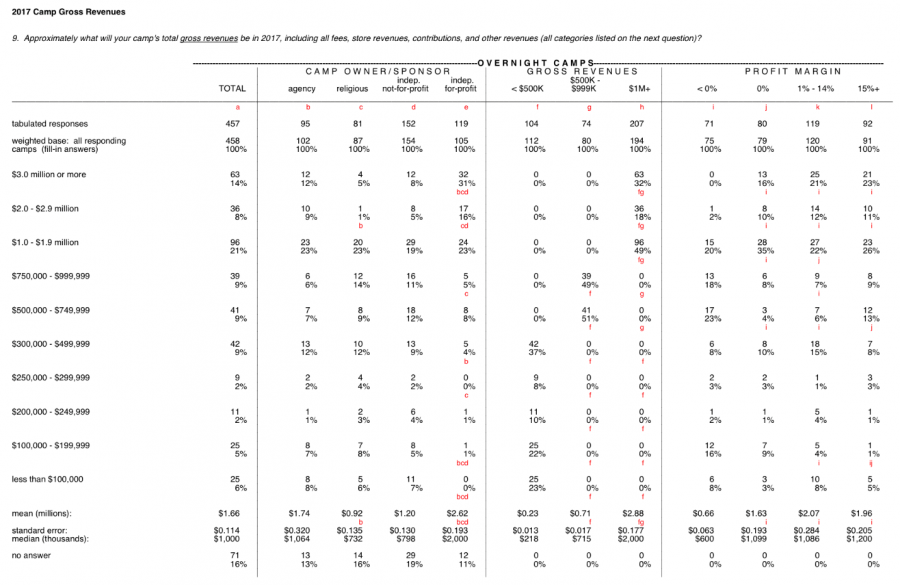Hello camp evaluators, and happy fall season. While some of you are as busy as ever, others are taking a deep breath for the first time in months. No matter where you are at, you are probably at or soon approaching a point where you will look back on summer 2018 and wonder, How did we do?
Measuring success in camp is far more difficult than you might think. Is success measured by revenue? Enrollment? How you measure success depends on program goals, size, facilities, and other available resources, all of which vary from camp to camp. So, success is often a big question of “it depends.”
Because of that, many organizations turn to benchmarks, or standards set either by an external source (like an industry standard), or through an internal measure (like past year’s performance). In some cases, external standards provide a reliable metric by which to measure your camp’s success; but, we need to be careful when comparing ourselves to other camps because camps — even ACA-accredited camps — differ tremendously in size, location, goals, budget, and length of operation. In other words, comparing two camps is like comparing apples to oranges. . . or apples to oranges to mangos, or mangos to tomatoes (which are, in fact, fruit), or tomatoes to. . . you get the picture.
We have two options to help us get around this all-too-tempting fruit salad. The first is to measure ourselves against a sample of similar camps, and the second is to compare ourselves to the only camp that is truly comparable: our own camp. We call these external and internal benchmarks, respectively.
External benchmarks are data gathered from a group of camps and organized by camp type—day camp and overnight camp, for example. Although camps vary tremendously within these categories, they are still useful benchmarks because the data represent the average of a group of camps instead of any one camp in particular. Some examples of external benchmarks include camper enrollment, number of camp staff, and revenue.
Where might you find these benchmarks? A good place to start are ACA’s Business Operations Reports. We collect data from camps related to their programs, campers, staff, expenses, revenue, scholarships, and facilities every year, and the reports break this information down by camp type (day or overnight), affiliation (nonprofit, for-profit, affiliated with an agency, or affiliated with a faith-based institution), budget size, and region. By breaking the data down like this, individual camps can compare their own data with camps most similar to their own.
Let’s look at the following table — these data represent the average gross revenues for overnight camps in 2017. You can see average dollar values across different camps, and, at the bottom of the chart, you can see the mean value — the average — for each of these columns. In most cases, this value ($1.66 million) would serve as a reliable benchmark for gross revenue in ACA-accredited camps. . . but not so fast. There is another number we should pay attention to here: the median ($1 million). If we took all of the numbers for gross revenue reported across all camps, and laid them side by side in a line, the median would be the number exactly in the middle. We like to pay attention to this number because, unlike the mean, the median is not pulled higher or lower by numbers at the extreme ends. In other words, the median represents, in some cases, a true middle.
But what’s notable here is the difference between the mean and the median, and, in this case of gross revenues across overnight camps, that difference is significant. What does this mean? It means that camps vary radically, and industry norms based on averages, or means, must be used with caution when used as external benchmarks.

This is why internal benchmarks are often the most reliable and useful tool for measuring performance. An internal benchmark is information (data) you gather on a specific indicator of performance, such as annual enrollment, staff turnover, or profitability. The indicators you select to benchmark over time depend on your goals as a camp organization — we cannot focus on everything, so where might be a place to focus for the next several years? So, the first step to using benchmarking effectively is to identify which indicators best represent areas of growth or strategic focus for your camp.
Unlike external benchmarks, the internal measures we choose are subject to our own interpretation and bias. It takes discipline to collect information on a designated set of indicators consistently, in the same way, over a given period of time. And then it takes even more discipline to look frankly at those benchmarks and use what you learn to guide decisions moving forward. Internal benchmarks are also prone to shifting over time, perhaps in relation to our own biases, so it is important systems in place to make sure these metrics are truly helping us improve over time.
Interested in benchmarking? There are two additional tools you can check out — both free. The Camp Program Quality Assessment Tool is a tool built specifically for internal benchmarking. This tool uses best practices in program quality as a framework for observing camp activities, staff interactions with campers, and administrative practices so that camps can improve continuously in these areas over time.
The second tool is for camps interested in measuring camper outcomes — the skills, beliefs, and behaviors that campers gain when they attend camp. ACA’s Youth Outcomes Battery is a set of surveys — 12 to be exact — designed to measure outcomes such as friendship skills, responsibility, and problem solving confidence, at camp. Interested in benchmarking camper outcomes? Check out the Youth Outcomes Battery Norms. (National averages broken down by age and camp type.)
Benchmarking is a powerful tool for continuous program and operational improvement. Both internal benchmarks and external benchmarks provide powerful check-points as you reflect back on the 2018 summer. More importantly, though, are they ways these benchmarks can help inform your decisions moving forward — perhaps something to consider during this fall season of reflection.
Photo courtesy of Davis Family YMCA Day Camp in Youngstown, Ohio.
Laurie Browne, PhD, is the director of research at ACA. She specializes in ACA's Youth Outcomes Battery and supporting camps in their research and evaluation efforts. Prior to joining ACA, Laurie was an assistant professor in the Department of Recreation, Hospitality, and Parks Management at California State University-Chico. Laurie received her PhD from the University of Utah, where she studied youth development and research methods.
Thanks to our research partner, Redwoods.
Additional thanks goes to our research supporter, Chaco.
The views and opinions expressed by contributors are their own and do not necessarily reflect the views of the American Camp Association or ACA employees.





